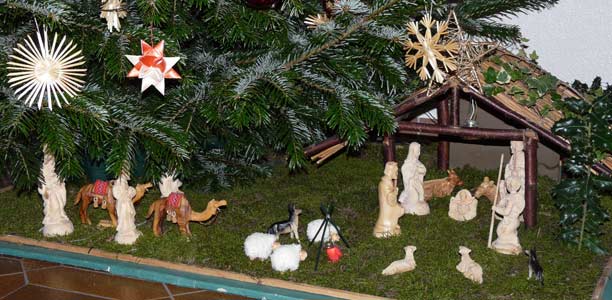Christmas, or Weihnachten, is the most important of the major holidays in Germany. Although it is becoming less about religion and more commercialised, the German holiday season remains a time for contemplation, celebration and family and friends; and despite the commercialisation Christmas is less consumption-oriented than in some parts of the world.
Key Terms
Christmas: Weihnachten
Date: 24th December is the main Christmas celebration, however many Christmas rituals occur early in December, for example Santa Claus arrives on December 6.
Santa Claus: Sankt Nikolaus, Weihnachtsmann or Christkind in different regions of Germany
Christmas Eve: Heiliger Abend or Heiligabend
Christmas tree: Weihnachtsbaum
Merry Christmas: Frohe Weihnachten
Nativity: Krippe
Christmas preparations
Advent wreaths and calendars
 The German Christmas season officially begins with the first Sunday of Advent which is the first Sunday after November 26. Four Advent Sundays lead up to Christmas. The Advent wreath (Adventskranz) is decorated with four candles, one of which is lit on each of the four Advent Sundays.
The German Christmas season officially begins with the first Sunday of Advent which is the first Sunday after November 26. Four Advent Sundays lead up to Christmas. The Advent wreath (Adventskranz) is decorated with four candles, one of which is lit on each of the four Advent Sundays.
To involve kids a bit more in the festivities leading up to Christmas, the Germans invented the Advent calendar (Adventskalender). The calendars are usually made of cardboard and have little doors for each of the 24 days counting down to Christmas. A candy is hidden behind each one. Advent calendars can be bought at shops or Christmas markets, however some people make their own calendars and put little gifts behind each door.
Cooking
Common family activities during advent include special evenings for baking spiced cakes (Stollen) and cookies, and making gifts and decorations.
Santa Claus (Sankt Nikolaus)
December 6 is Nikolaustag, St. Claus day. Children place a boot in front of the door in the hope that Nicholas might fill it with nuts, fruits, chocolate, and sweets. If the children have behaved well, their wishes will be fulfilled. Naughty children will receive only a rod, which symbolises punishment for their bad behaviour.
Christmas markets (Weihnachtsmarkt)
 At the start of the Advent season Christmas markets pop up at local squares and other locations in nearly every German town, large or small. The town squares, which become dark early in the day in winter months are often covered in snow. During the Christmas market they are lit up and buzzing with activity. People gather together, listen to Christmas music, drink hot mulled wine (Glühwein) and enjoy the hearty traditional food of the region such as Bratwurst (a thick pork sausage), Kartoffelpuffer (potato fritter), hot soup, Schupfnudeln (finger-shaped potato dumplings).
At the start of the Advent season Christmas markets pop up at local squares and other locations in nearly every German town, large or small. The town squares, which become dark early in the day in winter months are often covered in snow. During the Christmas market they are lit up and buzzing with activity. People gather together, listen to Christmas music, drink hot mulled wine (Glühwein) and enjoy the hearty traditional food of the region such as Bratwurst (a thick pork sausage), Kartoffelpuffer (potato fritter), hot soup, Schupfnudeln (finger-shaped potato dumplings).
Baked goods, including gingerbread (Lebkuchen) hearts and houses, sugar-roasted almonds, butter cookies, stollen and other traditional sweets are also on offer. Christmas tree decorations, seasonal items, and handcrafted articles, such as beautiful wooden toys and hand-blown glass ornaments, are also sold.
Christmas tree (Weihnachtsbaum)
Christmas trees are traditionally set up and decorated on Christmas Eve, December 24. Some families cut down their own tree. It’s usually a fir tree or a spruce. The tree is decorated using tinsel, glass balls, straw ornaments and sweets. A star or an angel tops the Weihnachtsbaum, and beneath the tree, a nativity scene is usually set up with the presents next to it.
Germans often use real lit candles instead of electric lights on the tree. Christmas trees are very important in Germany. If there are young children in the house, the trees are usually secretly decorated by the mother of the family.
Christmas Eve
Christmas Eve is the main day of the Christmas celebration in Germany and the day when families exchange their presents. German families secretly place their gifts under the Christmas tree on Christmas Eve. The day begins as a regular working day. But around noon businesses and shops close in preparation for the holiday celebration.
Christmas Eve dinner
 Families have a special dinner together- it’s common to serve carp for this meal. Depending on the region, typical food at Christmas Eve can also be sausages with potato salad, or sausages with sauerkraut and mashed potatoes.
Families have a special dinner together- it’s common to serve carp for this meal. Depending on the region, typical food at Christmas Eve can also be sausages with potato salad, or sausages with sauerkraut and mashed potatoes.
Christmas songs and stories
After Christmas dinner families sit around the Christmas tree and sing Christmas carols. They may also tell Christmas stories, amongst which the tale of Jesus Christ’s birth is popular and often read aloud from a book.
Christ child and Santa Claus
In most parts of Germany it’s neither St. Nikolaus nor Santa Claus who bring children their presents on Christmas Eve. It’s the Christkind, or Christ child. But it’s not the actual baby Jesus in the manger; instead he is represented as a golden female angel. In some other parts of Germany the Weihnachtsmann (Santa Claus or Father Christmas) brings the presents on December 24th.
The Weihnachtsmann, much like Santa Claus, is a jolly old man with a long white beard in a red fur suit, with a sack of presents and a rod. Depending on the German region it is either the Weihnachtsmann or the Christkind (Christ child) who leaves gifts for the children to open on Christmas Eve. German children may be worried about him being able to deliver the all the presents as he has so many to get through on Christmas Eve.
Religious activities
On Christmas Eve many German families attend a midnight mass service. This is true of Protestants and Catholics (the two major religious denominations) and even those who are not regular church-goers. Christmas mass traditionally takes place at midnight, but in recent times the services have been moved into the earlier evening hours to better suit families.
Christmas day(s)
Both December 25 and 26 are legal holidays in Germany and are known as the First and Second Christmas Day (der 1 und 2 Weihnachtsfeiertag) respectively. What originally started out as a church celebration of Christ’s birth has gradually become a family celebration. Businesses are closed, and time is spent visiting the extended family. A special meal is eaten on the first Christmas day. The second Christmas day is usually a quieter day, a day for peaceful contemplation.
Christmas dinner
In many regions Goose with red cabbage and potato dumplings is the traditional food on the First Christmas Day, sometimes a roast. It is eaten at lunch time and the table is usually beautifully decorated with the Advent wrath, and more candles.
Post-Christmas
Epiphany/Three Kings’ Day (Heilige Drei Könige)
The German Christmas season isn’t officially over until Epiphany, or Three Kings’ Day which occurs on January 6. Heilige Drej Konige is considered the day of the arrival of the three “kings of the orient” in Bethlehem. It also marks the official end of the festive season.
On this day the Sternsinger (star singers) go from house to house, sing a song, write a signature with chalk over the door of the house symbolising protection and collect money for charity. This is a predominantly Catholic tradition. The Sternsinger are four children, three who dress up like the Wise men. One carries a star on a stick as a symbol for the Star of Bethlehem.
The Christmas tree (Weihnachtsbaum) is usually taken down on January 6th.
Read More
 |
Find out about Christmas celebrations in other parts of the world. |




 (3 votes, average: 3.67 out of 5)
(3 votes, average: 3.67 out of 5) 






